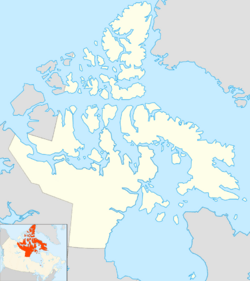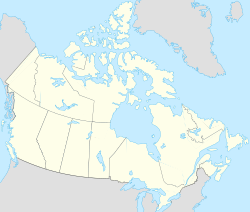Jenvey Island facts for kids
| Geography | |
|---|---|
| Location | Frobisher Bay |
| Coordinates | 63°35′30″N 68°8′42″W / 63.59167°N 68.14500°W |
| Archipelago | Canadian Arctic Archipelago |
| Administration | |
|
Canada
|
|
| Nunavut | Nunavut |
| Region | Qikiqtaaluk |
| Demographics | |
| Population | Uninhabited |
Jenvey Island is a small, uninhabited island in the cold Canadian Arctic Archipelago. It's part of the Qikiqtaaluk Region in Nunavut, Canada's largest and northernmost territory. This island is found in Frobisher Bay, which is a large inlet of the Labrador Sea. It sits southeast of Iqaluit, the capital city of Nunavut.
Contents
Exploring Jenvey Island
Jenvey Island is one of many islands located in Frobisher Bay. Because it's uninhabited, it remains a wild and natural place. The island is part of a vast network of land and water in the Canadian Arctic.
Nearby Islands
Jenvey Island has many neighbors in Frobisher Bay. Some of the other islands close by include:
- Algerine Island
- Alligator Island
- Aubrey Island
- Coffin Island
- Gardiner Island
- Pan Island
- Ptarmigan Island
- Sale Island
These islands are all part of the same amazing Arctic environment. They are important for the local wildlife and the overall ecosystem of the region.
Geography of the Arctic Islands
The Canadian Arctic Archipelago is a huge group of islands in northern Canada. It includes some of the largest islands in the world. These islands are mostly covered by tundra, which is a type of biome where tree growth is difficult because of low temperatures and short growing seasons.
Frobisher Bay's Location
Frobisher Bay is a long inlet that cuts into Baffin Island, which is Canada's largest island. The bay is named after Sir Martin Frobisher, an English explorer who explored the area in the 1570s. The bay is an important waterway for local communities and wildlife.
Wildlife in the Arctic
Even though Jenvey Island itself is uninhabited, the surrounding Arctic region is home to many amazing animals. You might find polar bears, seals, walruses, and various types of whales in the waters and on the ice. Many different kinds of birds also visit the Arctic during the warmer months.
Arctic Adaptations
Animals in the Arctic have special ways to survive the cold. Many have thick fur or blubber to stay warm. Some animals, like the Arctic fox, change their fur color to blend in with the snow in winter. These adaptations help them live in one of the coldest places on Earth.



